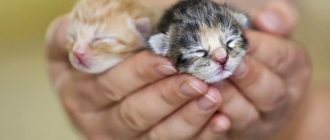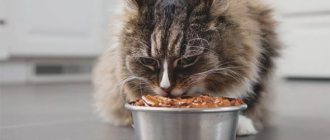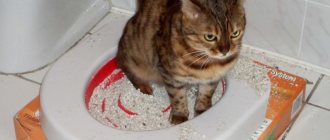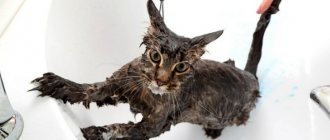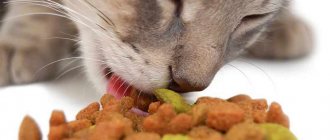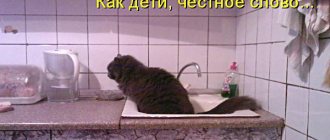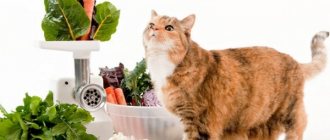Underweight is no less dangerous than obesity. Most often it is associated with poor living conditions and selectivity in food. Because of this, many owners try to cope with the problem on their own and are looking for ways to fatten their cat without seeking help from a veterinarian.
But we must not forget about pathological factors that affect appetite and nutrient absorption. In these cases, the animal requires mandatory treatment, so to be on the safe side, it should be scheduled for examination at a veterinary clinic.
Factors influencing growth
Gender also affects the size of the animal, for example, the muzzles of females are almost always narrower and more elongated than those of cats. If the cat's face stops growing, it means that the skeleton is formed, the head and shoulder width will remain at this level and will not grow any further. As a rule, this occurs by 2 years.
Internal factors
The age at which cats grow is not the only factor in an animal’s growth. There are external and internal factors influencing the development of an animal. The main internal factor is breed. Representatives of large breeds grow longer than miniature ones.
What to do if the kitten does not grow
As soon as it becomes noticeable that his kitten is no longer growing, you should urgently contact a veterinarian, because each case is unique and requires an individual examination. Most often, the diagnosis will be one or more of the above reasons. They are eliminated like this :
Thus, to find out exactly why a kitten is not growing, it is best to consult with a specialist who will identify the cause and prescribe the correct treatment for your pet.
Viral infection
Infectious diseases, colds or intestinal diseases are another common reason that a kitten is not growing or gaining weight. The mucous membrane through which nutrients are absorbed is affected. Even if the baby maintains a good appetite, the supply of proteins, fats and carbohydrates necessary for his growth and development slows down greatly or stops altogether. The kitten does not grow and does not gain weight, since its body simply has nothing to build its cells and tissues from.
Sometimes a kitten does not grow or gain weight even some time after the illness due to deep organic damage to the intestines. In this case, the recovery period is delayed and the owners feel that the kitten is not growing. In this case, there is no need to panic. A few days of a gentle diet, a course of vitamin therapy and the weight quickly returns to normal.
Unbalanced diet
An unbalanced diet is the second most common reason that a kitten does not grow or gain weight. Delay in development occurs as a result of feeding food that does not contain the substances necessary for its growth - proteins, fats, vitamins and microelements. If the animal is not fed properly, it may show signs of rickets and anemia. The kitten is not growing, the weight gain is very insignificant, it is lethargic and sits near the bowl for a long time, waiting for more nutritious food. If these signs appear, you should review your pet’s diet and adjust it according to its age.
Features of cat growth
The growth of cats is not only an increase in body length and weight gain. Growth is the complete formation of all organs and systems in the body of an animal. However, when choosing a pet, cat lovers attach importance to external indicators: length and height of the body, weight, etc. The size of the cat depends on the breed, health status and living conditions. Often a pet stops growing due to belonging to a certain breed. The kitten begins to grow rapidly at the age of six months.
Read also: iPhone does not see Wi-Fi
Some kittens don't grow up to be big cats because of their breed.
Stages of growth
There are four periods of cat growth (from birth to adulthood):
- The first period is neonatal. These are the first four days of a kitten's life. At this time, the weight of the animal may change (increase or decrease). The nature of the changes depends on how the birth proceeded.
- Next comes the suckling period. At this stage, the kitten is steadily gaining weight. The suckling period lasts about a month.
- The transition period lasts from four to seven weeks. At this time, the kitten's growth slows down. The animal switches to a different type of nutrition: kitten milk is replaced with solid food. After a complete transition to “teenage” nutrition, growth accelerates.
During the transition period, the kitten begins to eat solid food instead of mother's milk. - After 7–8 weeks, the post-lactation period begins. It lasts until the final formation of the body. The kitten grows independently and ceases to depend on feeding from the mother.
What natural foods to feed your cat to make her gain weight
When fattening, you should avoid too fatty foods (pork, lard, cream) and feeding from the human table. Such food worsens the functionality of the gastrointestinal tract, causing new complications.
The main emphasis should be on calorie content, choosing foods with high energy value. It is recommended to include in the menu:
- chicken, rabbit, lamb and veal, containing large amounts of animal protein;
- boiled vegetables (zucchini, pumpkin, carrots), bran and oatmeal, enriched with fiber;
- sea fish, offal, chicken and quail yolks, characterized by a wide variety of vitamins and minerals in their composition;
- fermented milk products with low fat content, which have a beneficial effect on the functioning of the cardiovascular system and the musculoskeletal system;
- jellied cartilage, containing collagen beneficial for joints;
- buckwheat and rice porridge, which normalize peristalsis and digestion.
Instead of milk, it is better to use artificial milk formulas from a pet store. Otherwise, your pet may have digestive problems.
Malnutrition
One of the most common reasons why a kitten is not growing or gaining weight is a lack of food. The smallest babies may simply not have enough mother's milk. In this case, you will have to feed the kittens manually. At an older age, the kitten does not grow due to the too meager rations that it receives. Normally, a one and a half month old baby is fed up to 5 times a day. At this age, his stomach is small and cannot accommodate large volumes, so he is fed often, in small portions.
Worm infestation
Worms can also lead to weight loss. In this case, the kitten does not grow or gain weight due to the fact that the parasites suck out all the nutrients from the food, leaving nothing for its owner. A characteristic sign of helminthic infestation is the animal’s good appetite with low body weight gain. The kitten is not growing or gaining weight, although it is eating well and its tummy feels firm to the touch. Constipation or diarrhea may occur. When examining stool, helminth eggs are found. How to deal with this disease is here.
When is it time to sound the alarm?
The cat is drooling: the main causes and treatment options
Cats begin to worry about being thin if:
- the cat eats a lot and often, but does not gain weight, it is too light and small for its breed (thin cats do not gain weight);
- the spine can be traced visually (the ridge literally protrudes outward);
- the pelvic bones and ribs protrude, their movement is clearly noticeable when the cat moves;
- the cat’s breath smells unpleasant (obviously, the gastrointestinal tract is disrupted, the kidneys and liver are not functioning properly, plaque or caries may have formed on the teeth);
- there is no fat layer on the chest and back area, only bone;
- the cat does not show usual attention to toys, sleeps constantly;
- the animal has loose stools (if mucus, blood, or undigested parts of food are found in the stool, consult a doctor);
- yellowness or excessive pallor of the mucous membranes is observed, they become gray in color (most likely, weight loss is due to problems with the liver and kidneys);
- more fluid is released from the eyes, nose and mouth than usual, especially when an unpleasant odor appears, a change in the color of the animal’s tears and saliva;
- the temperature rises (hot nose, the cat is lethargic, to check the temperature it is enough to use a regular thermometer);
- the stomach is sunken, hard, tense.
The silhouette of an emaciated cat resembles an hourglass.
When the described signs appear, the animal is weighed (to do this, just place it in a bag and use a steelyard or in a cardboard box, cover the top with something and put it on a regular floor scale).
If the cat always eats well, but is very thin, weighs 1 kg or more less than it should, contact a veterinarian. It is first necessary to take weight measurements for several weeks in a row to make sure that there really is a reason for concern (cats are thin and do not gain weight for various reasons, but most often due to illness).
How to fatten a cat without it being fat
When fattening, it is important not to overdo it, as obesity can cause even more problems. To do this, be sure to control the growing indicator and avoid the most common mistakes.
Weight control
Weigh your pet on a floor or kitchen scale every week. If you gain too quickly, adjust your daily caloric intake or add more activity.
What mistakes should you avoid?
Self-feeding is often accompanied by mistakes. For the safety of your pet, try to avoid sudden changes in diet or mixing different types of food, handouts from the table, uncontrolled eating and infrequent feeding. All these situations can lead to indigestion or obesity.
Why is the cat thin and not getting fat?
The normal weight of a cat is between 3.5 and 5 kg. It all depends on the breed. Cats of different origins differ in activity, dynamics and metabolism. In adulthood, the individual reaches 7-8 kg. You can find out why a cat doesn’t get fat if you understand how nutrition affects your pet’s body.
When a cat is thin and does not gain weight, but eats a lot, this does not mean that the pet is sick. If an animal spends its days running and jumping around the apartment or on the street, losing weight and not gaining weight becomes a good sign. The body consumes the energy received from food, the digestive system develops and functions in a stable manner.
© shutterstock
Other reasons for losing weight include:
- A cat cannot gain weight after giving birth. If there are more than 2 kittens in the litter, you should not count on rapid weight restoration. Carrying out such a brood takes a lot of effort and energy. Therefore, mother cats will need time.
- Males begin to lose weight during the period of sexual heat, as do females. In spring, the body of cats and dogs is especially active. Castration will help: sterilized cats simply have nothing to do, so such animals gain weight instantly.
- Pets are not adapted to stressful situations and therefore do not gain weight. Street cats are constantly under threat. An uninvited guest, a new pet in the apartment, or even a newborn baby can shock a furry animal. Refusal to eat is a natural reaction.
- If the cat eats well and does not gain weight, the problem may be a helminthic infestation. Helminths enter the body through the dirty hands of the owners, an unwashed tray, and dirty water. It is better to start treatment immediately: the period of getting rid of worms can last up to six months.
- It is useless to feed old cats heavily. With age, the activity of females and males decreases. Cats spend more and more time lying down and moving little. This does not indicate illness: the cat will not eat more than the body needs.
- Vitamin deficiency leads to weight loss. Industrial feed will correct the situation. Artificial formulations (available in dry and liquid forms) contain mineral supplements and restore the balance of beneficial components in the body.
The dangers of excessive fattening
For those owners who want to fatten their pet for their own aesthetic needs - to admire how funny the cat licks or runs - it is useful to learn about the consequences of feline obesity. Since obesity in cats, like in humans, is a disease, a fat cat will sooner or later face health problems, including:
- Diabetes of the second type - being initially not prone to diabetes, your pet can develop it with an incorrect lifestyle and, in particular, nutrition.
As a result, the owner will have to periodically inject insulin into the cat in order to avoid a sharp deterioration in his health; Diabetes is one of the most dangerous consequences of overfeeding a cat. - Cardiovascular diseases - the higher the weight of the animal, the greater the load on the heart.
Overweight cats, as a rule, rarely move and prefer a recumbent lifestyle, which only aggravates the situation; Gaining excess weight is fraught with heart attacks leading to heart attack - High probability of joint injury - any long-distance jumps can result in dislocations, or, in the worst case, fractures.
Since the bones and joints of each cat are tailored to a certain body weight, which has its own threshold, going beyond its limits is fraught with all sorts of injuries; Overweight cats have a more difficult time recovering from fractures due to the heavy load on the joints. - Predisposition to arthritis.
Fat animals are the first at risk in terms of the likelihood of becoming acquainted with this unpleasant disease, accompanied by inflammation of joint tissues and deformation of the limbs, not to mention purulent complications; In advanced cases, arthritis can only be treated with a surgical scalpel - Hypertension - this disease is difficult to diagnose in the initial stages, but its harm to the entire body is very great. In its chronic form, hypertension leads to hypertrophy of the heart muscle, which, with the least favorable prognosis, ends in cardiac arrest.
Keep in mind that a deviation of one and a half kilograms from the norm is already considered obesity and unsafe for the pet’s health. Since pets differ significantly from us in size, they only need to gain a few hundred grams for this to become noticeable. You can read about the process of losing weight in cats on our portal.
Video - Consequences of obesity in cats
Chronic form
If the kitten is very thin - does not grow, lags behind its healthy peers in development, but the above symptoms manifest themselves weakly (the eyes are a little watery, slight discharge from the nose, etc.), then perhaps the disease is chronic. The most dangerous cat disease with similar manifestations is coronavirus infection, especially when it causes infectious peritonitis. In its wet form, the kitten has a large belly and is thin when viewed from above or touches the spine. The abdominal cavity is soft, slightly painful, and fills with fluid due to the inflammatory process.
Genetic and pathological causes
Although poor nutrition or the presence of parasites may explain why a kitten is not growing, there are a few rare reasons why a kitten may be short. The kitten may be born healthy. Since they have not yet been developed, it can be difficult to determine if they are underdeveloped. After a few weeks, we will be able to better understand whether their growth is actually stunted.
© shutterstock
It is also easier to determine a kitten's growth rate if it stays with its littermates. By comparing a kitten with its siblings, we can tell if there are problems with their growth. If so, they may have one of the following conditions:
- Congenital hypothyroidism : The thyroid gland is a gland that helps control a cat's metabolic rate by secreting hormones.
- Mucopolysaccharidosis : is a term for a number of diseases that are caused by enzyme deficiencies.
- Pituitary dwarfism : This is a condition caused by a deficiency of growth hormone.
- Portosystemic shunt: In this case, there is a circulatory problem that prevents the body from processing toxins properly.
Every cat matures differently
The animal reaches its maximum size when the skeleton is finally formed. Therefore, in order to understand when growth stops, you should pay attention not to the pet’s weight, but to the length of the limbs, body size and the distance between the shoulder blades.
It is difficult to say exactly how long cats grow. Pets of small and medium breeds are fully formed by one year, maximum by 1 year and 2 months, but the formation of large breeds can last up to 3 years.
Not only the breed, but also the gender of the pet plays a role. Females, for example, upon reaching sexual maturity by 9 months, in most cases no longer grow or increase slightly in size. But males grow even after full puberty. This means that even within the same breed, the weight and size of animals of different sexes may differ. For example, the female of one of the most popular breeds today, the British, weighs approximately 5-6 kg, while the weight of males varies from 7 to 11 kg.
How to understand how much weight a cat has?
Despite the fact that it is difficult to mistake an emaciated cat for a well-fed one, as well as vice versa, there are nuances and transition states that it is advisable to pay attention to. Thus, gradual weight loss may be an indicator of a developing disease. Weight gain may indicate an incorrect diet and disproportionately large portions.
Table 1. Weight categories for cats
| Underweight | Normal weight | Excess weight | Moderate obesity | Severe obesity |
| Bones (especially the pelvic bones and ribs) show through and are visible to the naked eye in smooth-haired and hairless individuals | The animal has the correct proportions; when viewed from above, the cat's body takes on the shape of an hourglass. | Fat accumulates primarily in the back, abdomen and face | The bones are indistinguishable and can barely be felt. The fat layer appears in the abdomen, chest and beginning of the tail | Pronounced accumulations of fat in the back, base of the tail, chest and abdomen |
| Lack of fat on the chest and ribs | The ribs have a thin layer of fat, but are easily palpable | The ribs can be felt but not visually identified | The ribs can only be felt when pressing | The ribs and spine are indistinguishable under a layer of fat |
| No belly fat | A small amount of belly fat | Marked abdominal fat when viewed from the side | When viewed from the side, accumulations of fat on the abdomen are noticeable | The belly sag noticeably due to fat |
| The waist is sharply defined due to the sunken belly | The waist is distinguishable, but does not provide a clear contrast with the ribs | The waist is vague, the body shape resembles a rectangle | The waist is almost indistinguishable | When viewed from above, the waist forms a circle, making the cat look like a bowling pin. |
Cat weight on a scale of ten
The vast majority of cats grow and gain weight before they reach one year of age. They develop especially quickly during the first six months, gaining on average 150-200 grams daily. Over the next six months, the kittens develop their body structure and develop sexual differences, ending by the age of one year. Of course, each breed has its own optimal weight. Maine Coons will likely be heavier than Miniature Munchkins and Sphynxes.
Different breeds have their own weight standards
The average mongrel cat weighs from three to six kilograms. The cat is inferior to him in weight by 1-3 kilograms. However, even outbred cats have different skeletons. The expression “broad bone”, in addition to an ironic connotation, also has a completely serious meaning. Different cats with different bone structure and thickness have different weight standards. With the same 5 kilograms of weight, we can observe both a plump and a fit individual.
Weight categories of cats depending on breed
Therefore, one of the main signs of thinness-fullness is the ability to palpate or visually identify the ribs and chest. The more difficult it is to do this, the greater the deviation of the animal’s weight towards fullness.
